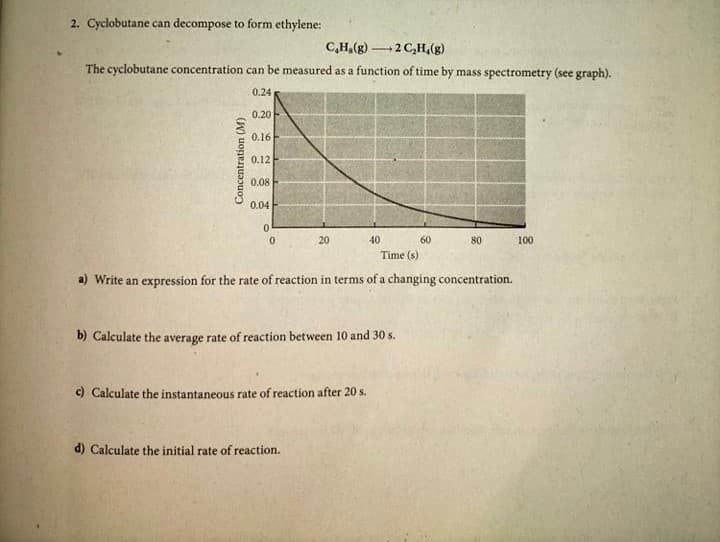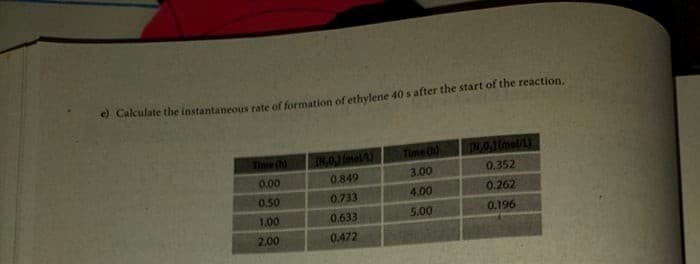2. Cyclobutane can decompose to form ethylene: C,H,(g) 2 C,H,(g) The cyclobutane concentration can be measured as a function of time by mass spectrometry (see graph). 0.24 0.20 0.16 0.12 0.08 0.04 20 40 60 80 100 Time (s) a) Write an expression for the rate of reaction in terms of a changing concentration. b) Calculate the average rate of reaction between 10 and 30 s. ) Calculate the instantaneous rate of reaction after 20 s. d) Calculate the initial rate of reaction. Concentration (M)
2. Cyclobutane can decompose to form ethylene: C,H,(g) 2 C,H,(g) The cyclobutane concentration can be measured as a function of time by mass spectrometry (see graph). 0.24 0.20 0.16 0.12 0.08 0.04 20 40 60 80 100 Time (s) a) Write an expression for the rate of reaction in terms of a changing concentration. b) Calculate the average rate of reaction between 10 and 30 s. ) Calculate the instantaneous rate of reaction after 20 s. d) Calculate the initial rate of reaction. Concentration (M)
Chemistry: The Molecular Science
5th Edition
ISBN:9781285199047
Author:John W. Moore, Conrad L. Stanitski
Publisher:John W. Moore, Conrad L. Stanitski
Chapter11: Chemical Kinetics: Rates Of Reactions
Section: Chapter Questions
Problem 12QRT: Cyclobutane can decompose to form ethylene:
The cyclobutane concentration can be measured as a...
Related questions
Question

Transcribed Image Text:2. Cyclobutane can decompose to form ethylene:
C,H,(g)2 C,H,(g)
The cyclobutane concentration can be measured as a function of time by mass spectrometry (see graph).
0.24
0.20
0.16
0.12
0.08
0.04
20
40
60
80
100
Time (s)
a) Write an expression for the rate of reaction in terms of a changing concentration.
b) Calculate the average rate of reaction between 10 and 30 s.
c) Calculate the instantaneous rate of reaction after 20 s.
d) Calculate the initial rate of reaction.
Concentration (M)

Transcribed Image Text:e) Calculate the instantaneous rate of formation of ethylene 40 s after the start of the reaction.
Time (h)
INOJ Imel/
Time Ch)
DOlmol/L)
0.00
0.849
3.00
0.352
0.50
0.733
4.00
0.262
1,00
0.633
5.00
0.196
2.00
0.472
Expert Solution
This question has been solved!
Explore an expertly crafted, step-by-step solution for a thorough understanding of key concepts.
Step by step
Solved in 2 steps with 2 images

Knowledge Booster
Learn more about
Need a deep-dive on the concept behind this application? Look no further. Learn more about this topic, chemistry and related others by exploring similar questions and additional content below.Recommended textbooks for you

Chemistry: The Molecular Science
Chemistry
ISBN:
9781285199047
Author:
John W. Moore, Conrad L. Stanitski
Publisher:
Cengage Learning

Chemistry & Chemical Reactivity
Chemistry
ISBN:
9781133949640
Author:
John C. Kotz, Paul M. Treichel, John Townsend, David Treichel
Publisher:
Cengage Learning

Chemistry & Chemical Reactivity
Chemistry
ISBN:
9781337399074
Author:
John C. Kotz, Paul M. Treichel, John Townsend, David Treichel
Publisher:
Cengage Learning

Chemistry: The Molecular Science
Chemistry
ISBN:
9781285199047
Author:
John W. Moore, Conrad L. Stanitski
Publisher:
Cengage Learning

Chemistry & Chemical Reactivity
Chemistry
ISBN:
9781133949640
Author:
John C. Kotz, Paul M. Treichel, John Townsend, David Treichel
Publisher:
Cengage Learning

Chemistry & Chemical Reactivity
Chemistry
ISBN:
9781337399074
Author:
John C. Kotz, Paul M. Treichel, John Townsend, David Treichel
Publisher:
Cengage Learning

Chemistry: Matter and Change
Chemistry
ISBN:
9780078746376
Author:
Dinah Zike, Laurel Dingrando, Nicholas Hainen, Cheryl Wistrom
Publisher:
Glencoe/McGraw-Hill School Pub Co

Principles of Modern Chemistry
Chemistry
ISBN:
9781305079113
Author:
David W. Oxtoby, H. Pat Gillis, Laurie J. Butler
Publisher:
Cengage Learning

Chemistry
Chemistry
ISBN:
9781305957404
Author:
Steven S. Zumdahl, Susan A. Zumdahl, Donald J. DeCoste
Publisher:
Cengage Learning